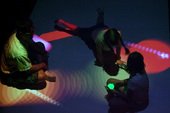Highlight
SMALLab K-12 Work at Local High School
Achievement/Results
Over the past two years, the K-12 Embodied and Mediated Learning group has developed an experiential infrastructure for education, the Situated Multimedia Arts Learning Laboratory [SMALLab]. Within SMALLab, learners use a set of “glowballs” to interact in real time with each other and with dynamic visual, textual, and sonic media through full body 3D movements and gestures. Our work specifically targets the needs of students with diverse learning styles including active learners and those who are underserved by the traditional culture of schooling.
During the 2007-08 school year our team permanently installed SMALLab at a regional urban high school. Throughout the year our team of interdisciplinary faculty, graduate researchers, and IGERT trainees have directly collaborated with a cohort of science (Earth Science, Chemistry, and Physics) and language arts teachers to implement and evaluate new SMALLab learning scenarios. Subsequently, over 100 underserved and at-risk students from the school’s C.O.R.E. program have participated in SMALLab learning programs. As a direct result of their participation in SMALLab, students have demonstrated double-digit content learning gains in the sciences and have achieved significant increases in their spatial reasoning abilities. Furthermore, we have documented substantial motivation and buy-in from students, teachers, and administrators that enable us to expand the research programs across the entire campus during the 2008-09 school year.
The SMALLab team also recently received a nearly $600,000 grant to share with the New York City-based non-profit, Institute for Play, from The John D. and Catherine T. MacArthur Foundation. This project expands SMALLab’s reach to the East Coast, resulting in the design and development of a suite of standards-based learning scenarios using the SMALLab environment for eventual installation in Quest to Learn, a new 6-12 grade school in New York City.
Address Goals
This system extends beyond existing educational approaches with the realization of a hybrid physical-digital framework for content learning that integrates emerging research across engineering, the learning sciences, psychology, and the humanities. This is of tremendous potential benefit to K-12 students and an important tool for their teachers. The IGERT trainees and associates involved in this project collaborate with faculty and graduate students from other disciplines, gaining a broader perspective on their research. Trainees and associates are also actively involved in applying their research in the community, engaging students of various ages in their research activities.






